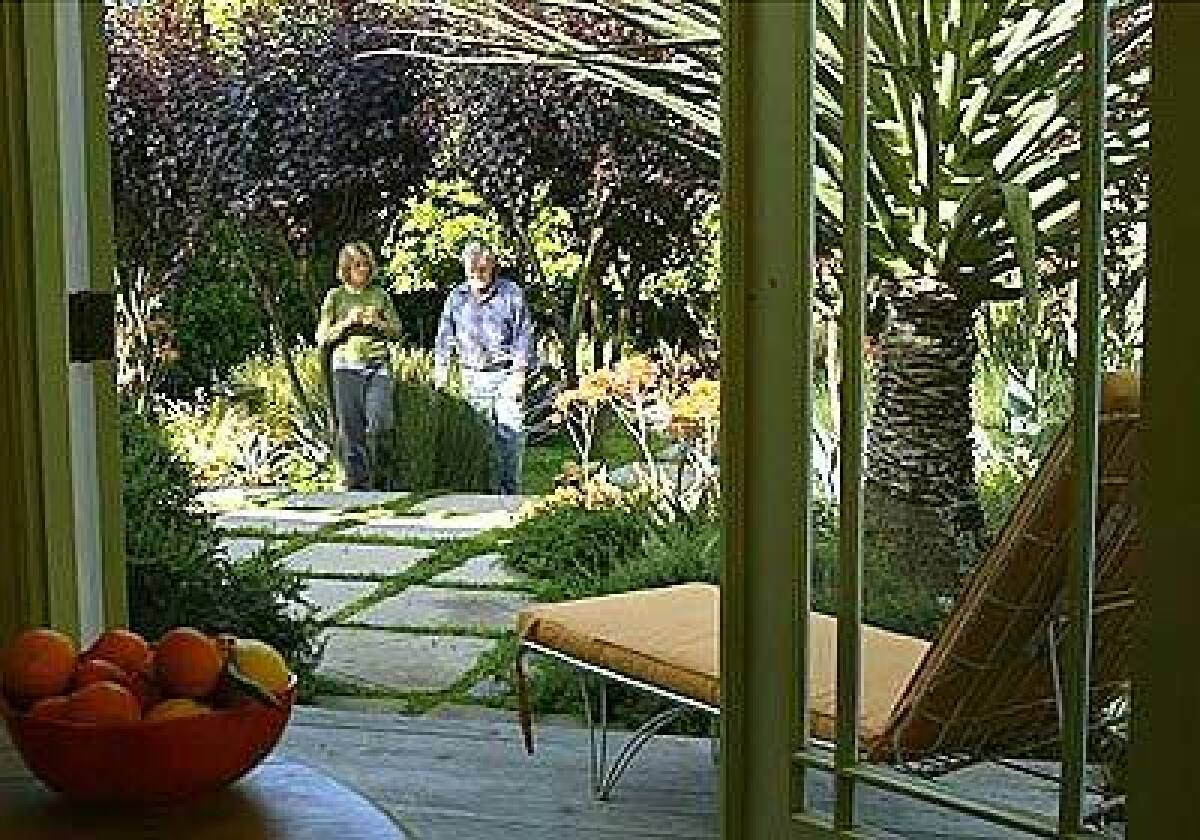Cutting the lawns in Venice

- Share via
In Venice, a “Keep Off the Grass” sign would be pretty much moot. Here, where lot sizes invite comparisons to postage stamps, the symbol of suburban excess — the expansive green lawn — is almost nowhere evident.
On Saturday, 31 private gardens will be open for the 10th anniversary of the annual Venice Garden Tour, and “easily 80% to 85% of them don’t have grass,” says Jan Brilliot, who is co-chairing the event with landscape designer Jay Griffith.
The tour was conceived in 1994 by Venice residents Brilliot, Griffith and Linda Lucks to benefit the nonprofit Neighborhood Youth Assn.’s Las Doradas Children’s Center, which provides child care and after-school programs for at-risk children in the Oakwood area.
It began in a remarkably modest way, showcasing a handful of gardens designed, for the most part, by Griffith. The trio thought they’d hit pay dirt that first year, pulling in $1,200. “We were jumping up and down, thrilled,” Griffith says. Last year, the amount was $160,000, with the aggregate total over the last decade creeping up on $1 million. “People have told us over and over that this is the best garden tour they’ve ever been on,” Griffith says. “They’re bowled over by the wit and freedom of expression. It’s just amazing the stuff that’s happening here. It’s a little Oz with something new around every corner.”
This year the tour will feature seven of Griffith’s creations, including the garden designed for Brilliot using primarily drought-tolerant plants — a Griffith signature — and recycled concrete from the property that he cut up into pavers and transformed into an elevated patio. When he first saw the yard, “it was a wasteland,” Griffith says: dead crabgrass, one dead apricot tree, an old washtub, gravel and 200 pounds of used cat litter scattered along the fence. “Jan was on a strict budget,” he says, “and we had to make do with the resources at hand. She couldn’t afford to have irrigation put in. We did it on an absolute shoestring.”
They planted a row of red ornamental plums through the middle of the garden and a row of citrus in back. Griffith constructed a box of recycled concrete for a raised vegetable bed, tucked behind landscaping.
The remainder is a mix of silver-blue agaves and tall orange and magenta cannas interspersed with a sweep of chartreuse helichrysum, aloe and recycled succulents — which also fill the old washtub.
“True gardens are about nurturing. Grass is about maintenance,” Griffith says. “You get a better bang for your buck aesthetically and environmentally without it.”
Despite the lawnlessness of most of the gardens on the tour, all of them are distinctly different, as individual as the people who created them — “people who watch their gardens grow instead of TV,” Griffith says. A few are quixotic personal statements, “world-class outsider art pieces.” There are gardens with dozens of glass swag lamps hanging from tree limbs, prolific beds of roses, tropical motifs and postmodern minimalist planting.
Landscape architect Russ Cletta, one of Griffith’s partners, created a garden with the clever use of concrete and strong tropical accents for architect Daniela Rechtszaid and her husband, Juan Jose Quintana, paying particular attention to scale and function. “The idea was to keep it clean and adaptable for different uses,” Cletta says. Although the garden has yet to mature, its bones are set. Concrete pavers combine with mid-ground plantings in concrete plinths to give the illusion of depth. The space is further defined by a dining area under a modern aluminum pergola and an L-shaped cedar bench supported by more plinths.”Lawn and grass has its place, but it’s not appropriate in an urban setting with such tight constraints,” Cletta says. “You just have to be careful not to overrun the space with concrete. You don’t want it to look like one big slab.”
In Venice’s Milwood neighborhood, the fragrance from Maureen Eisner’s garden envelops even passersby, as roses entwine with clematis vines and spill over her picket fence. Flowers in her garden may be abundant, but grass is not. The front is covered with roughhewn slabs of chocolate flagstone, the back with recycled bricks from a Pasadena teardown.
“Lawns are more formal,” says Eisner, a self-taught garden and house designer who specializes in building Craftsman-style houses with her husband, John. “It’s just not Venice. People want to experiment here.” Besides that, you needn’t ever worry about groundcover and brick. “If somebody comes over with their dog, you don’t have to freak out that they’re gonna leave a yellow spot on your grass.”
Between the bricks, designed in a swirling pattern, Eisner has planted several variations of thyme. “I like the way the brick meanders, and I love the way when you walk over it you get the scents of thyme.”
The garden so enchanted neighbor Julia Roberts and her husband Danny Moder, who had already bought a house built by the Eisners, that they hired Maureen to design one for them.
“Grass uses an incredible amount of water,” Brilliot says. “It looks wonderful in England where it rains a lot, but in a Mediterranean climate, it’s so unfriendly to the water supply and the environment. It’s not correct for our climate. People are starting to see how much more interesting a garden can be when they take that space and make it into a true outdoor room.”
*
Take the tour
The 10th annual Venice Garden Tour takes place Saturday, 10 a.m. to 5 p.m., and begins at the Las Doradas Children’s Center, 804 Broadway. Tax-deductible tickets are $50; children younger than 12, free. (310) 577-6668 or e-mail venicegardentr@aol.com; https://www.venicegardentour.org .






